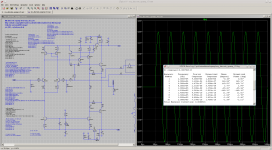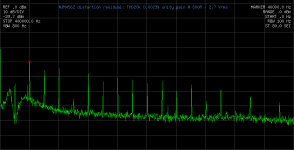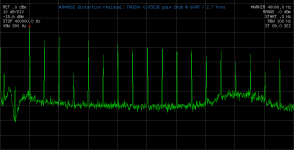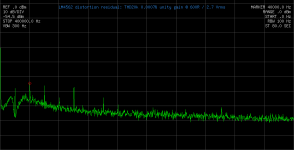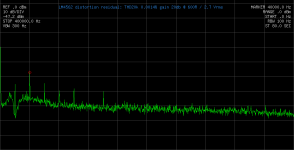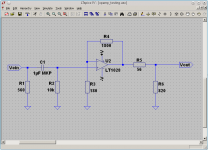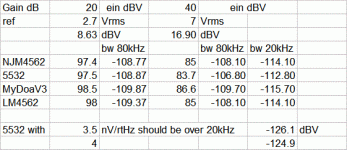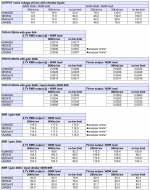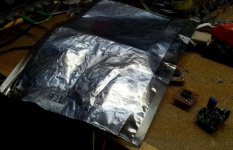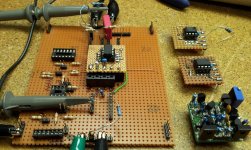Dear Toni,
My Congratulations to Yours results achieved 🙂
I feel You nail it closely to Bursons, it is not only measured thd an noise that counts but way much more to the transient-dynamic ability for the DOA v3 to pass much more current in time domain at needed speeds at the transients demanded by a complex music eg. Mahler 8th. symph. with full tutti - choir + orchestra at the loudest passages to easily follow even the single instruments or the individual sections of the whole happening on the stage. Here are under covered the true qualities of Your DOA comparing to the small and polished silicon cross section areas packed in a tinny small dip or sot packages. I think the listening comparation should be the final proof for You and also for the others admiring Yours work You've done so fare. So please follow Yours ears and continue - You'll be surprised . . .
With my best regards
Andreas
Dear Andreas,
thank you for the encouraging words! I will build some MyDOAs for listening tests too as I need them (or LM4562/LME49990) for my preamp project's buffers and gain stage.
BR, Toni
Toni, I would really like to know your reasons for this.I personally would never use NJM4562 in the audio signal path.
I've mentioned some good reasons why I would or wouldn't use LM4562 🙂
Only one of the reasons not using NJM4562 is >= 2k instead of 600R possible output load... and therefore more noise ...Toni, I would really like to know your reasons for this.
I've mentioned some good reasons why I would or wouldn't use LM4562 🙂
To discuss qualification of commercial opamp's we should use another thread. 🙂
MyDOA v3 in principle is the input/VAS stage of SA2013 with a different OPS and therefore I decided to present it in this thread.
Still missing your answer to MyDOA v3 ... 😉
BR, Toni
NJM4562 is designed for 600R load and for medium gain amps, practical S/N as good as LM4562. See NwWavGuy's very detailed measurements on the page I linked.Only one of the reasons not using NJM4562 is >= 2k instead of 600R possible output load... and therefore more noise ...
I can't explain your better results for BF245 as CCS .. except to second keantoken's point about the SPICE BF245 being much worse than 'real life'.Still missing your answer to MyDOA v3 ... 😉
For more stuff on discrete OPA's , I offer my #2060 example in discrete-opamp-open-design
This attempts & achieves SOA performance using the simplest possible circuit. There are further simplifications and enhancements further on in that huge thread. I hope to simplify it even further.
Datasheet of NJM4562 says nothing about 600R.NJM4562 is designed for 600R load and for medium gain amps, practical S/N as good as LM4562. See NwWavGuy's very detailed measurements on the page I linked.
...
The measurements from "NwWavGuy's" site clearly states: genuine National 4562 has been tested (which implies that they never have tested a NJM4562) ...
They tell us "Mouser" have not LM4562 but NJM4562 on stock - this is a really big (and maybe wanted) mistake. Give me (and "Mouser" ) some days and I will include NJM4562 in MyDOA tests.
IMHO: the NJM4562 isn't in any way comparable to LM4562.
Normally you don't need the tests - if you compare the datasheets you know that these two opamps are NOT comparable. Or would you try to compare a µa741 with NE5532?
Maybe some days anyone has an explanation ......
I can't explain your better results for BF245 as CCS .. except to second keantoken's point about the SPICE BF245 being much worse than 'real life'.
I like the simulations as you can check very fast all worst case parameters like power dissipation and so on, but there is also some (minor or major) difference between simulation and measurements. Example: MyDOA-V3 simulation said: very stable GM and PM but very bad behaviour on square wave - real life measurements showed the opposite that MyDOA-V3 has a very good behaviour on square wave - and a very flat response till several hundreds of kHz (4Vpk@600R). (for our SR fans: SR is measured > 35V/µs)
Thx. 990 designs are well known here too.For more stuff on discrete OPA's , I offer my #2060 example in discrete-opamp-open-design...
Some notes about MyDOA-V3:
- PSRR is controlled by using for both rails a capacitance multiplier. CMRR need to be tested...
- MyDOA-V3 needs a dual power supply as LM4562. Maybe MyDOA has the same "latching" problems ...
My copy of NJM4562 datasheet says right at the top "The NJM4562 integrated circuit is a high-gain, wide-bandwidth, low noise, dual operational amplifier capable of driving 20V peak-to-peak into 600Ωloads. The NJM4562 is frequency compensated for closed loop gains greater than 10.Datasheet of NJM4562 says nothing about 600R.
The measurements from "NwWavGuy's" site clearly states: genuine National 4562 has been tested (which implies that they never have tested a NJM4562) ...
They tell us "Mouser" have not LM4562 but NJM4562 on stock - this is a really big (and maybe wanted) mistake. Give me (and "Mouser" ) some days and I will include NJM4562 in MyDOA tests.
NwWavGuy explains how he uses it in his amp near the bottom of the comments on his op-amp measurements article.
If you didn't measure or try it out, you would not find the reasons I WOULD NOT use LM4562 in many applications. These are not mentioned in the National datasheet.Normally you don't need the tests - if you compare the datasheets you know that these two opamps are NOT comparable.
If you do manage to try NJM4562 against LM4562 on simple amps, please post the results. You are one of the few people who can measure the difference.
_____________
As for my FET990 example, I think you'll find the performance exceeds most of the other 990 variants.
Linuxguru has some further simplifications near the end of the thread but I haven't had time to look at these properly.
OT: discrete opamp
Sorry - my reading mistake. The THD plot values @ 2k load implied, that the opamp is not capable to drive 600R loads. Not unity gain stable?
Maybe your reading mistake:
Yesterday I have ordered 5 pieces of NJM4562 from mouser to test them for the diyaudio community. 😉
Think your FET990 (have you ever built it?) will outperform the NJM4562.🙂
Br, Toni
My copy of NJM4562 datasheet says right at the top "The NJM4562 integrated circuit is a high-gain, wide-bandwidth, low noise, dual operational amplifier capable of driving 20V peak-to-peak into 600Ωloads. The NJM4562 is frequency compensated for closed loop gains greater than 10.
...
Sorry - my reading mistake. The THD plot values @ 2k load implied, that the opamp is not capable to drive 600R loads. Not unity gain stable?
...
NwWavGuy explains how he uses it in his amp near the bottom of the comments on his op-amp measurements article.
...
Maybe your reading mistake:
LM4562 NOISE: While the National LM4562 isn’t available from Mouser, the NJM4562 is and they perform very similarly. Here’s the genuine National part and it’s noise performance turns out to to be nearly identical to the NE5532:
The presented screenshot was taken with "the genuine National part".
...
If you do manage to try NJM4562 against LM4562 on simple amps, please post the results. You are one of the few people who can measure the difference.
...
Yesterday I have ordered 5 pieces of NJM4562 from mouser to test them for the diyaudio community. 😉
Think your FET990 (have you ever built it?) will outperform the NJM4562.🙂
Br, Toni
The bit I'm referring to isn't in the main article but his reply to a comment by other people at the bottom of the page.LM4562 NOISE: While the National LM4562 isn’t available from Mouser, the NJM4562 is and they perform very similarly. Here’s the genuine National part and it’s noise performance turns out to to be nearly identical to the NE5532:
Both SWOPA and my circuit will have slightly better noise than LM4562 in something like NwWavGuy's amp.Think your FET990 (have you ever built it?) will outperform the NJM4562.🙂
I have no handle on the other performance parameters. I'm just playing with SPICE and I've no reliable models for LM4562.
But with Scott Wurcer's SWOPA, there is enough similarity in SPICE world for me to think my poor efforts will be close to SWOPA. ie if SWOPA beats LM4562, I think so will mine. Both mine & SWOPA don't have the latching.
Somewhere in that huge thread, I mention some things which need addressing to get near the potential performance of his AD797, his SWOPA and also my little circuit. These will also apply to LM4562 or NJM4562
Linuxguru has built a version of my circuit but I'm not sure exactly what it is. I'm hoping to get a sample to RNMarsh to test but I need to check it out first.
OT: Comparing LM4562 with NJM4562
Today I got some pieces of JRCs NJM4562 (top of chip: 4562D / JRC / G001B) to compare with LM4562.
Power supply +/- 17V
Surprise: my test exemplar of NJM4562 seems to be unity gain stable.
Here are the THD20k results. Think NJM4562 is a good harmonic synthesizer compared to LM4562 or NE5532. 😉
BR, Toni
Today I got some pieces of JRCs NJM4562 (top of chip: 4562D / JRC / G001B) to compare with LM4562.
Power supply +/- 17V
Surprise: my test exemplar of NJM4562 seems to be unity gain stable.
Here are the THD20k results. Think NJM4562 is a good harmonic synthesizer compared to LM4562 or NE5532. 😉
BR, Toni
Attachments
Thanks for this Toni.Today I got some pieces of JRCs NJM4562 (top of chip: 4562D / JRC / G001B) to compare with LM4562.
Power supply +/- 17V
Surprise: my test exemplar of NJM4562 seems to be unity gain stable.
Here are the THD20k results. Think NJM4562 is a good harmonic synthesizer compared to LM4562 or NE5532. 😉
What was your test circuit?
Can you do some comparative tests with gain of 40dB with 1k8 & 18R2 feedback network? Perhaps at a higher O/P eg 10Vp (7Vrms) 600R
Also comparative output noise with this high gain and shorted i/p ?
Last edited:
Thanks for this Toni.
What was your test circuit?
Can you do some comparative tests with gain of 40dB with 1k8 & 18R2 feedback network? Perhaps at a higher O/P eg 10Vp (7Vrms) 600R
Also comparative output noise with this high gain and shorted i/p ?
Attached test circuit. The photo of the lab test you can see some posts before.
NJM4562 THD20k@gain40db@7Vrms is 0.28%
NE5532AN THD20k@gain40db@7Vrms is 0.042%
MyDOA-V3 THD20k@gain40db@7Vrms is 0.019%
LM4562 THD20k@gain40db@7Vrms is 0.0095%
All above measurements with no bandwidth limiting.
R3 was set to 18R during test.
I will stop testing here this cr...y opamp.
Now it's time to design the PCB for MyDOA-V3 to get a feeling if pcb layout allows more fine tuning to get MyDOA-V3 more close to LM4562 values.
Br, Toni
Attachments
Thanks for this Toni.Attached test circuit.
NJM4562 THD20k@gain40db@7Vrms is 0.28%
NE5532AN THD20k@gain40db@7Vrms is 0.042%
MyDOA-V3 THD20k@gain40db@7Vrms is 0.019%
LM4562 THD20k@gain40db@7Vrms is 0.0095%
All above measurements with no bandwidth limiting.
R3 was set to 18R during test.
If we can impose on more of your generosity, it would be really nice to have some noise measurements of the four above with your 1k8 & 18R feedback network .. especially as it seems you can do noise both wideband and bandlimited noise. 🙂
_______________
How do you decouple your rails? Where do you have your decoupling caps?
OT: discrete opamp
Opamp noise measurements compared:
Output level for gain 20db was 2.7Vrms
Output level for gain 40db was 7Vrms
All values have been averaged using a function from VP7723D to get a stable reading at my environment.
At unity gain and 2.7Vrms SNR measures 111/117 db (no bw limit/80kHz bw) for all 4 types of opamps with a tolerance of +/- 0.5db. Seems to be the analyzer limit.
BR, Toni
Opamp noise measurements compared:
Output level for gain 20db was 2.7Vrms
Output level for gain 40db was 7Vrms
All values have been averaged using a function from VP7723D to get a stable reading at my environment.
At unity gain and 2.7Vrms SNR measures 111/117 db (no bw limit/80kHz bw) for all 4 types of opamps with a tolerance of +/- 0.5db. Seems to be the analyzer limit.
BR, Toni
Attachments
Thanks for this Toni.Opamp noise measurements compared:
Output level for gain 20db was 2.7Vrms
Output level for gain 40db was 7Vrms
All values have been averaged using a function from VP7723D to get a stable reading at my environment.
At unity gain and 2.7Vrms SNR measures 111/117 db (no bw limit/80kHz bw) for all 4 types of opamps with a tolerance of +/- 0.5db. Seems to be the analyzer limit.
BR, Toni
I don't quite understand how you are presenting these noise measurements.
Are the numbers with reference to the quoted 2.7Vrms & 7Vrms?
It's usual to do noise with shorted input or a specified source resistance and no signal. Shorted input would be good and easy for this test.
Then the noise would be at some absolute level, either dBV with reference to 1Vrms or dBu, wrt to 0.7746Vrms.
But MyDoaV3 looks very good in this company.
Last edited:
OT: discrete opamp
Thanks! Hopefully it sounds as good as it measures.😉
Attached the first variant of the MyDOA-V3 PCB - not really much spare space available for future extensions...
Br, Toni
The VP7723D itself does the SNR measurement in reference to the just before measured output signal level (have done measurements with unity gain and gain 20db @ 2.7Vrms; gain 40db @ 7Vrms). But can not say exactly as there is no good manual available for this old Panasonic/Levear equipment).Thanks for this Toni.
I don't quite understand how you are presenting these noise measurements.
...
...
But MyDoaV3 looks very good in this company.
Thanks! Hopefully it sounds as good as it measures.😉
Attached the first variant of the MyDOA-V3 PCB - not really much spare space available for future extensions...
Br, Toni
Attachments
Just a few calculations based on Toni's noise measurements. I normalise to the 'ref' voltages and subtract the gain.
Normalising to Ein gives 'similar' figures at 20dB & 40dB gain but I'm a bit suspicious that the 20dB gain figures are slightly better than the 40dB gain figures. It should be the other way round.
20kHz noise should be 6dB less than 80kHz noise provided hum/buzz is insignificant.
From Jurassic experience, I expect 5532 to have Ein within 2dB of this -124.9dBV spec in a properly designed and constructed LN amplifier. NOS Philips/Mullard 5532 (from the old Southampton plant) and lesser maker's 5534 about a dB worse.
Toni's results are more than 10dB worse so I'm still not sure what the VP7723D is showing. I don't think its short circuit noise. Perhaps it puts a resistor across the i/p when measuring noise.
Toni, how do you decouple power rails in the circuit from #772?
What value electrolytics? Are they physically AT the OPA (within 2cm) ?
But I think the relative noise performance of the 4 devices with LoZ source is valid. NJM4562 & LM4562 about the same. MyDoaV3 slightly better and 5532 slightly worse.
Normalising to Ein gives 'similar' figures at 20dB & 40dB gain but I'm a bit suspicious that the 20dB gain figures are slightly better than the 40dB gain figures. It should be the other way round.
20kHz noise should be 6dB less than 80kHz noise provided hum/buzz is insignificant.
From Jurassic experience, I expect 5532 to have Ein within 2dB of this -124.9dBV spec in a properly designed and constructed LN amplifier. NOS Philips/Mullard 5532 (from the old Southampton plant) and lesser maker's 5534 about a dB worse.
Toni's results are more than 10dB worse so I'm still not sure what the VP7723D is showing. I don't think its short circuit noise. Perhaps it puts a resistor across the i/p when measuring noise.
Toni, how do you decouple power rails in the circuit from #772?
What value electrolytics? Are they physically AT the OPA (within 2cm) ?
But I think the relative noise performance of the 4 devices with LoZ source is valid. NJM4562 & LM4562 about the same. MyDoaV3 slightly better and 5532 slightly worse.
Attachments
OT: discrete opamp
Dear Richard,
some more measurements for you to calculate. I have re-measured all devices using a simple EMI shield. (see attached pictures)
All other devices in the room have been switched off - even my PC
Decoupling under test socket:
Br, Toni
...
Toni, how do you decouple power rails in the circuit from #772?
What value electrolytics? Are they physically AT the OPA (within 2cm) ?
...
Dear Richard,
some more measurements for you to calculate. I have re-measured all devices using a simple EMI shield. (see attached pictures)
All other devices in the room have been switched off - even my PC
Decoupling under test socket:
2 x electrolytics decoupling 22µ
2 x 0.1µF
Decoupling on test socket as near as possible to chip:2 x 0.1µF
2 x 0.1µ +/- rail to ground and one extra 0.1µ rail2rail.
EMI shield betters the SNR values significant. Maybe this data and your calculations come now closer to the datasheets.
Br, Toni
Attachments
OT: discrete opamp

unable to upload the picture of the current pcb - diyaudio software problem?
No more disk space available?

unable to upload the picture of the current pcb - diyaudio software problem?
No more disk space available?
Last edited:
- Home
- Amplifiers
- Solid State
- 2stageEF high performance class AB power amp / 200W8R / 400W4R
